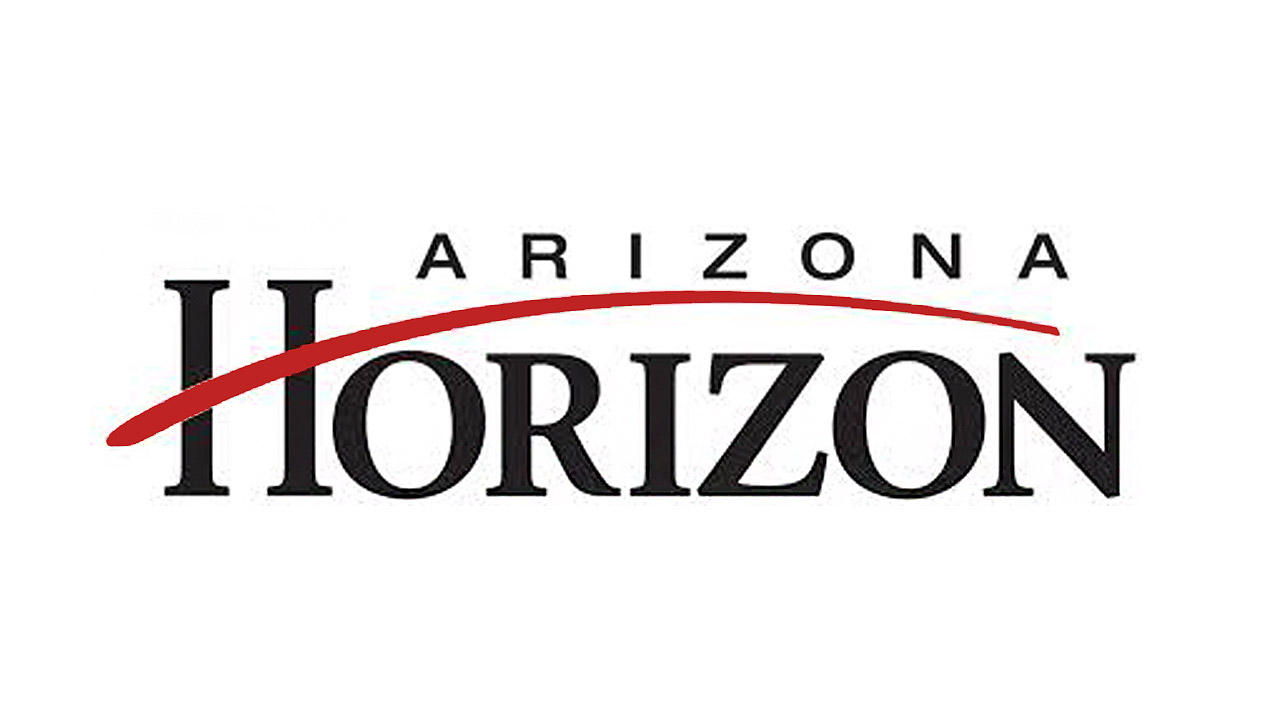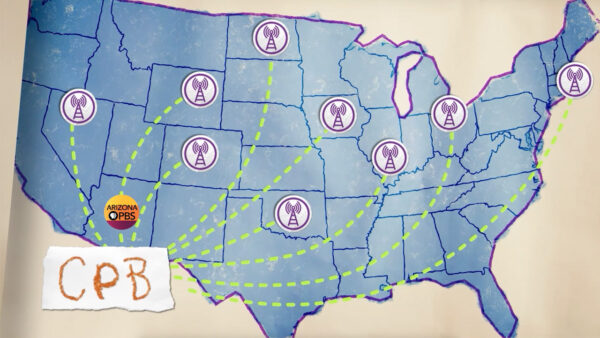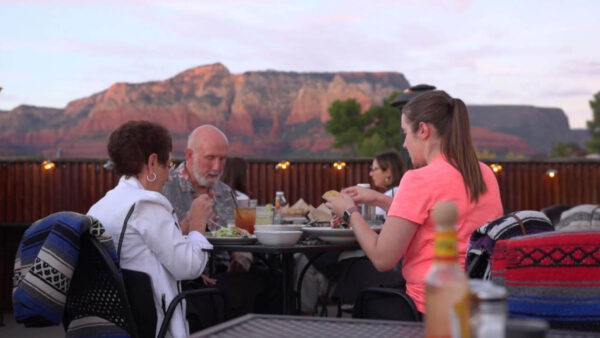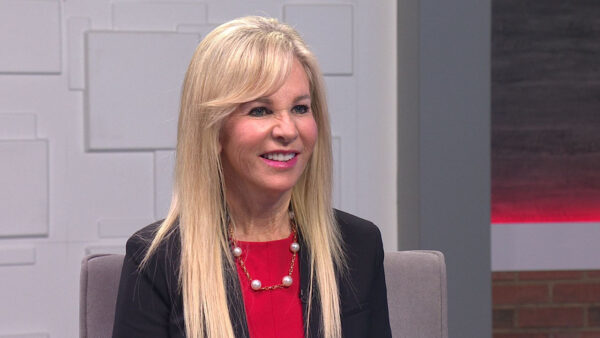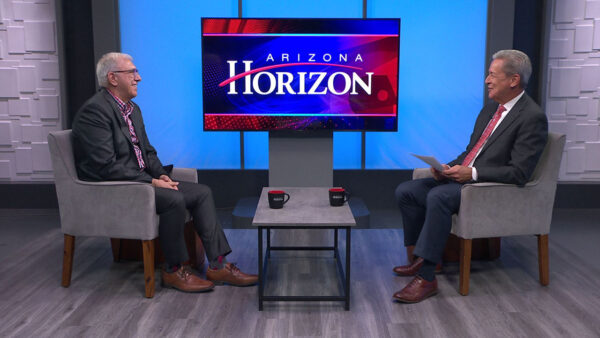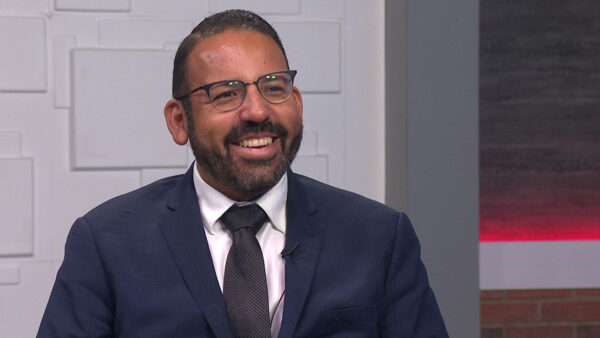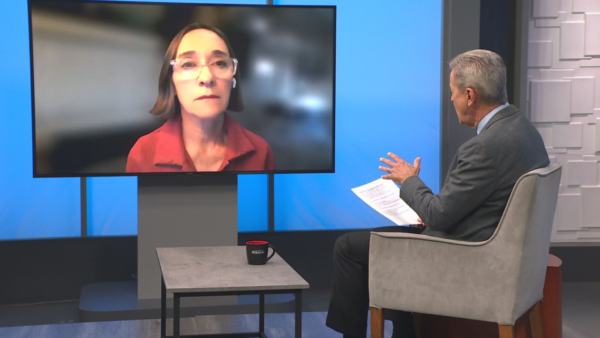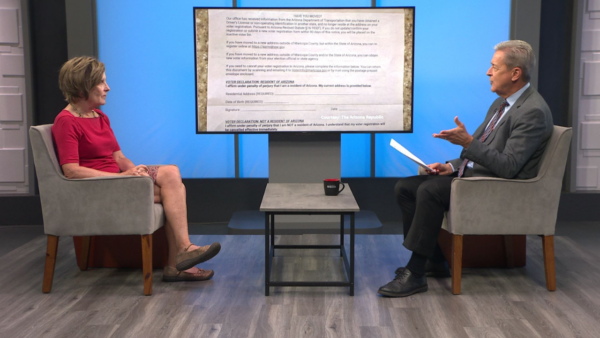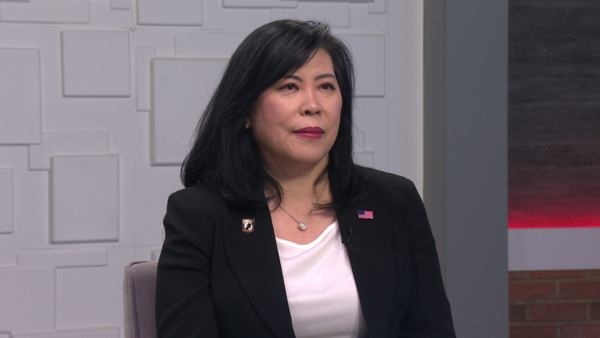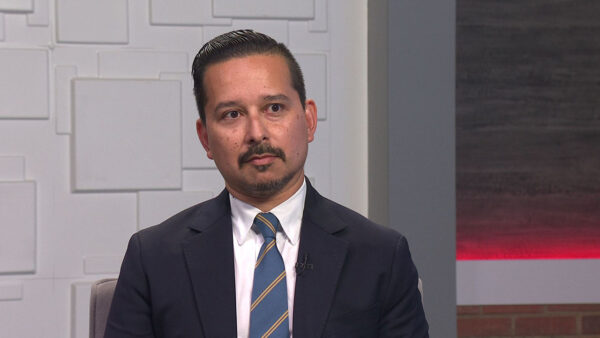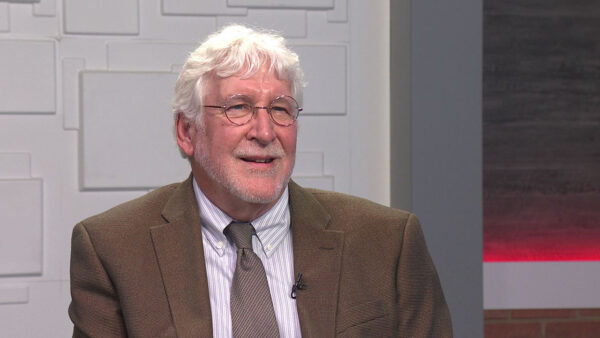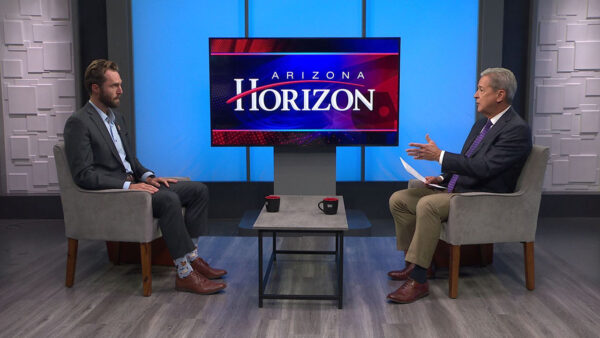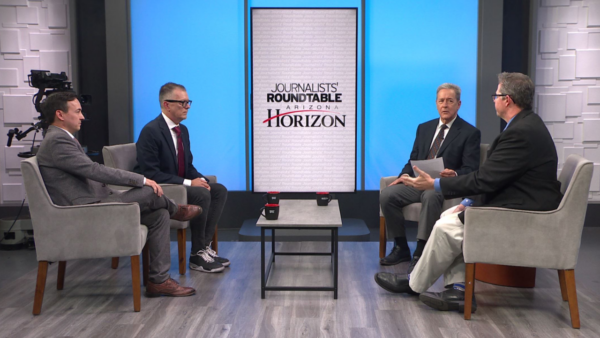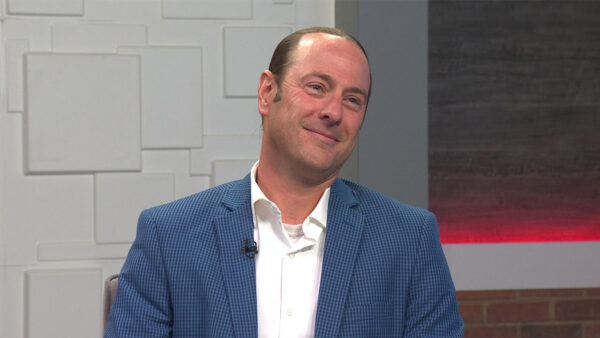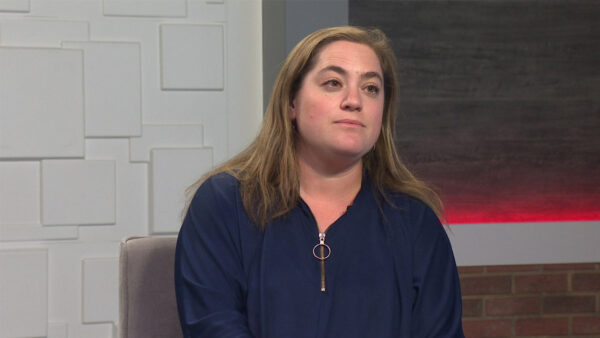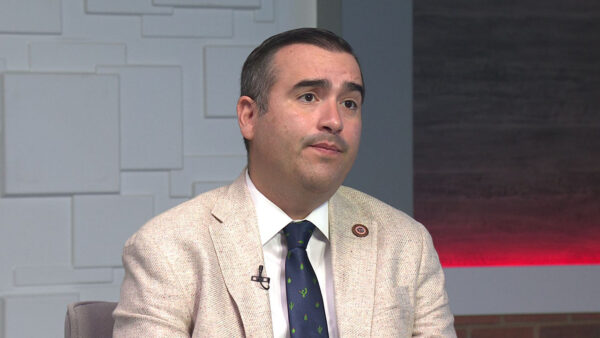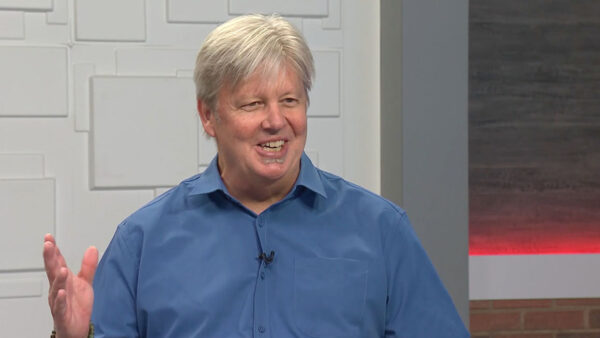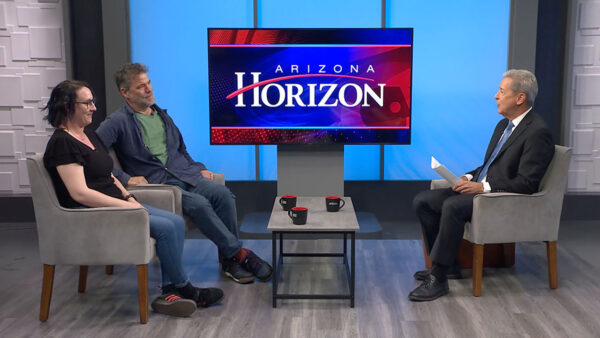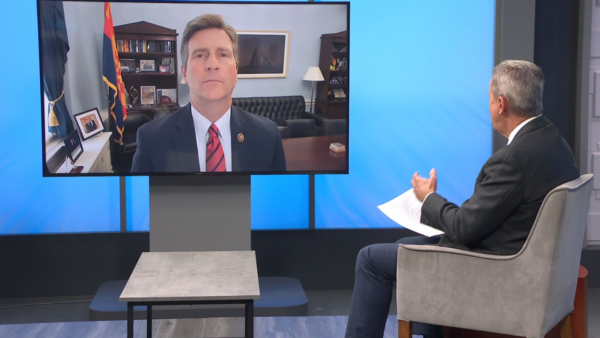Continuing our education series, ASU, the City of Phoenix, working together on a 15,000 student campus for ASU in downtown Phoenix. That agreement that will make it possible is announced today. And another approach to preparing for future university growth, the Board of Regents project to redesign the university system.
>> Michael Grant:
Tonight on "Horizon," continuing our education series, ASU, the City of Phoenix, working together on a 15,000 student campus for ASU in downtown Phoenix. That agreement that will make it possible is announced today. And another approach to preparing for future university growth, the Board of Regents project to redesign the university system. Those subjects next on "Horizon."
>>Announcer:
"Horizon" is made possible by the friends of Channel 8, members who provide financial support to this Arizona PBS station. Thank you.
>> Michael Grant:
Good evening, I'm Michael Grant. Welcome to "Horizon." First up, Governor Janet Napolitano signing a bill today that cracks down on uninsured and unlicensed drivers. Arizona drivers found at the scene of a traffic accident without auto insurance and drivers licenses will have vehicles impounded immediately for 30 days. The law also ups the mandatory fine for lack of insurance from 200 to 500 bucks, uninsured drivers will face a $700 fine for the second offense within three years. Also today the state legislature passing a bill would that ban the sale of soda pop and candy on Arizona's elementary, middle and junior high school campuses. Also known as the junk food bill, that law would prohibit the sale of empty calorie foods on school campus during the school day. Soft drinks and candy would still be sold at football games and after-school events. That bill now going to the governor for her expected signature. Arizona State University and the City of Phoenix partnering on a plan to establish a university campus in downtown Phoenix. Details of the commitment to build the campus as well as the financial obligations were released today. In a moment we'll get the details of the city's role in that agreement with Phoenix Mayor Phil Gordon. First, just a few minutes ago I talked with Arizona State University president Dr. Michael Crow about what this means for ASU.
>> Michael Grant:
Well, I'm going to start this at the same place where I think we did our last interview. Is my parking spot downtown anywhere in this intergovernmental agreement?
>>Dr. Michael Crow:
I think we have it as one of the main sort of features of the entire agreement. I think it's misted, air-conditioned.
>> Michael Grant:
I appreciate that. From a worldview and then we'll move in a little about it, it seemed to me that ASU was basically picking up operating and other costs. City of Phoenix obviously picking up a fair chunk of capital costs, construction costs.
>>Dr. Michael Crow:
Right, the basic finances of the deal is that the city will invest in getting us started with the initial facilities and the land that the facilities will go on. The university will move the five schools down to that site and we'll be off and running.
>> Michael Grant:
Refresh our recollection. I know nursing is in there, Cronkite --
>>Dr. Michael Crow:
Nursing, journalism, KAET television, college of public programs, which has three schools in it, public affairs, community development and social work and we're also moving our new university college headquarters there.
>> Michael Grant:
Before we started taping you mentioned to me other major cities with a much more major university college presence, obviously, than the City of Phoenix?
>>Dr. Michael Crow:
The City of Phoenix is now the fifth largest city in the United States and if you look at the four that are ahead of us, New York, Chicago, Los Angeles and Houston, all of those cities have deep and numerous colleges. We've got the private colleges in Phoenix. We've got the community college in Phoenix. Now we're building with the west campus in West Phoenix up to 15,000 students and this new campus in downtown Phoenix. Phoenix will have a 30,000-student public university.
>> Michael Grant:
Is that the projected build-out enrollment number, when?
>>Dr. Michael Crow:
15,000 downtown Phoenix as soon as we can get there. So it will be our -- our hope is that that's in the second phase of the project. We'll begin moving forward in late 2006. We'll move schools and programs into renovated facilities. Then we've got to build new facilities and we'll grow to that size as rapidly as possible.
>> Michael Grant:
The college of nursing has some interesting synergies just in terms of there are obviously a number of hospitals --
>> Dr. Michael Crow:
There's two major acute care hospitals right in the vicinity, there is the expansion of T-GEN, the building of the medical school which is under consideration at the legislature right now. There's the building by the University of Arizona and ASU of the Arizona biomedical collaborative building, construction for which will begin soon. All of these things link in well to the nursing school and other things that will be going on in that area.
>> Michael Grant:
Why is this the best location -- I don't mean downtown Phoenix Generally, but this particular area of downtown Phoenix?
>>Dr. Michael Crow:
Well, I think there's a number of reasons why this is a good location. First, to help build critical mass in downtown Phoenix as the urban center for finance, banking, journalism, education, government, to have that as a focused location, and we would be a part of all of that. Then for the university, to be of greater service to the citizens of Phoenix. It is important for Phoenix to be known as a college town also and this will help Phoenix to have that as one of its characteristics.
>> Michael Grant:
City of Phoenix have to use its condemnation power on some of the property.
>>Dr. Michael Crow:
I think a couple of the pieces of the property it may end up being the case but doesn't look like it will be a big deal.
>> Michael Grant:
Some of this property is just pretty much at this point in time laying idle.
>>Dr. Michael Crow:
A lot of sit parking lots and other things. It's basically between Fillmore and Van Buren, between 1st Avenue and central. It is property ready to be developed.
>> Michael Grant:
Now, I realize this is a little about it down the road, but any particular architectural theme? Some buildings will be remodeled, obviously some new buildings constructed. Any --
>>Dr. Michael Crow:
I don't know about so much of a theme for the architecture. We're going to focus on functionality and fitting into the urban environment. It's going to be a mixed-use campus, commercial space, residential space, academic space all together. So it will have the look of the city, but then there will be a park space. There will be public gathering space, public interaction spaces. We think all of those things will help us to put forth the kind of learning environment we need to do.
>> Michael Grant:
And a student housing component fits in as well.
>>Dr. Michael Crow:
There will be through partnerships with the private sector, there will be student housing developed, mixed income, mixed use housing.
>> Michael Grant:
I noticed the public-private partnership aspect in this thing in the story I read this morning in the paper. How does that work?
>>Dr. Michael Crow:
Right. The way that it works is that on the residence hall side, private developers would work with the university to help develop residence halls and then some of the additional properties near the site will be developed by private developers and in conjunction with their relationship with the city will make space available for the university.
>> Michael Grant:
So obviously the private part of that side throwing up the buildings and also -- and looking for the revenue stream, obviously, from the students that are house there had.
>>Dr. Michael Crow:
Yes.
>> Michael Grant:
And, again, walk through the -- just the basic outlines of the time line one more time.
>>Dr. Michael Crow:
The time line goes like this... land is being acquired now. The project is being planned. The City of Phoenix will hold a referendum on its bond -- renewal of its bonding with no additional expenditure on taxes for March of 2006. We hope to have the first waves of the program on site in August of 2006, and all of the new facilities up and running by 2008.
>> Michael Grant:
Okay. Dr. Michael Crow, thank you very much.
>>Dr. Michael Crow:
Thanks, Mike.
>> Michael Grant:
Some interesting stuff.
>>Dr. Michael Crow:
Yep.
>> Michael Grant:
City of Phoenix has agreed to finance the purchase of land as well as construct and renovate buildings for the project. It is a $233 million monetary commitment for the city, which could be part of a larger bond program that goes before voters in 2006. Joining us now to talk about the plan, why the city has committed to this, Phoenix Mayor Phil Gordon. Phil, good to see you again.
>> Phil Gordon:
Good to see you.
>> Michael Grant:
That's as good a place as any to start. $233 million. What's in it for the City of Phoenix?
>> Phil Gordon:
It's everything. First of all, it's economic development. Underutilized vacant property, blighted property that now will turn into a very productive institution. Arizona State University. Private property values that have been increasing. Joint public-private partnerships. Employment. Thousands of new jobs, both construction and faculty afterwards. It's the catalyst for the 24-hour, 7 day a week downtown that we've been needing. It's about bringing 15,000 students and faculty in one area. Let me put in that perspective. In three years we're going to have 7500 students and faculty in downtown Phoenix. After five years we've gotten 2500 great new jobs at the USAA plant in North Phoenix, which any state in any city has been killing to get. Here, if this was a private entity called business with 7500 people coming, every city in the world would be fighting for this relocation. This is also about educating for generations. Our future leaders in business, government, journalism, whatever. And if you think about it, Mike, the only institutions that have really been around 30, 40 years have been APS, SRP, the newspaper, the universities and government. So we're creating a lasting institution that will really be the catalyst for everything else we've been talking about and complement T-GEN and everything.
>> Michael Grant:
Give me the rough geographic boundaries that we're talking about.
>> Phil Gordon:
Roughly 1st Avenue to 1st street, Van Buren to Fillmore ending about where the old post office is. That also, then, will connect to the east to the Phoenix biomedical campus where the medical school, the pharmacy school, T-GEN is all located. So it really is about from Van Buren and 7th Street to Central.
>> Michael Grant:
One thing that caught my eye in the newspaper story this morning that I wanted to ask you about was the Mercado element. After ASU pays it off, it would move that to the City of Phoenix, what, about 15 years or so down the road.
>> Phil Gordon:
About 11 is what's estimated. So we will get two-and-a-half square blocks of city property, which is a valuable asset, property, that is part of this transaction also. The City of Phoenix will maintain the commercial income and revenue. These buildings will have retail and commercial projects to it. Private sector will build the housing. On the economics, the money we're talking about, candidly is about the same amount other cities have paid for to get a furniture store or a fishing store, an arena, and one thing I can promise you -- and that's good for those cities. That's what they want, great. But this is something Phoenix and the residents of Phoenix will leave a legacy for our future generations statewide because they'll be educating our statewide students, and that's something I would rather us be investing in. The other thing that's important to point out to your viewers is that ASU is committed, not only to transfer the Mercado, but to pay about 50, $60 million in operating costs, maintenance costs. They operate and maintain all these properties, and we receive the benefits.
>> Michael Grant:
Now, the light rail system, I'm trying to recall where it -- it's got to be right in the immediate vicinity.
>>Phil Gordon:
Exactly. Two stations -- it was critical to Dr. Crow and ASU that it be along the light rail line so that it can connect ASU, Tempe to ASU downtown Phoenix. So professors and students can teach and take classes at both campuses in less time than it takes to actually park and walk across a campus. They can study while they're on the light rail line. What's exciting now is, with Mayor Scruggs and some of my colleagues, we're looking -- at Dr. Crow, we're looking at now how we connect in the future ASU downtown to ASU West so that we actually literally leverage the resources of the state for everybody.
>> Michael Grant:
Still, from a political standpoint, quarter billion dollars, you know, you're close to talking real money. You're thinking of rolling into it a larger $750 million bond vote next year?
>> Phil Gordon:
Right. Again, let me put it in perspective. Certainly a lot of money but best investment we can make if that we invest a dollar in education, we're getting a known return. We can go through that, not only the economics I describe, but every student that graduates is a new student that's graduating, not taking away students from ASU. It's adding students. That will add a million dollars of new earning power over a 20-year working period of time. So multiply the number of students times that million. That's great. That's what we want. It's venture capital without a risk. And candidly, I would rather us be investing $180 million plus the 35 million for the park and other streetscapes in education, in the university, than a big box, a Wal-Mart.
>> Michael Grant:
Phoenix facing some tough budget times though right now. I could easily see people saying, hold it, you're talking about some cuts in some other areas, some belt tightening. Is in the time to spend 233 million on this?
>> Phil Gordon:
Absolutely we're going through a time of being conservative but again so the viewers understand, number 1, we're not talking about using general fund. We're talking about a bond campaign that's based on the income that's generated off of the property tax that the city receives. We're not talking about raising property taxes, either. That amount is within the existing tax rate that we set. So it can't go for operational money. This is capital money. In fact, that's the beauty of the ASU operation, is we'll build it out of capital funds that can't be used to hire police or librarians or water, and ASU will operate it. This will not take away from any of the operations we have. It will not use any of the general revenue. In fact, this is a leveraged ability partnering with the state so that we actually will build this institution that the state will actually get the advantage of also. Again, not only are we -- they don't have the capital --
>> Michael Grant:
The city on the on the other hand picks up the operational --
>> Phil Gordon:
ASU will. The state will get the added tax revenues generated off the increased property values in the private sector, the sales tax from the retail. This is such a win-win for everyone.
>> Michael Grant:
Phoenix Mayor Phil Gordon, stay in touch. Appreciate it.
>> Phil Gordon:
I will.
>> Michael Grant:
While Arizona's three campuses have their own unique missions and characteristics all are facing common challenges, expanding access to students across the state enhancing the diversity of the student body, correcting the inefficiencies within the university system and loosening financial constraints on both students and the state. Those challenges have compelled the Arizona Board of Regents to work to redesign the university system. Merry Lucero reports.
>> Merry Lucero:
Our state's three public universities, Arizona State University, the University of Arizona and Northern Arizona University all face the oncoming wave of economic and social changes. Among them, Arizona's rapidly rising population growth is expected to climb to more than 8 1/2 million people by 2020. Nearly 73,000 high school graduates are projected by 2018. And university enrollments currently at 115,000 could top 185,000 by 2020.
>> Mary Jo Waits:
We know we're a fast growing state but when you think about how many students we could potentially have and what's the capacity would it take to actually have, first and foremost, seats at the table, just to have a spot for them, that was a real eye opener, I think.
>> Merry Lucero:
So the Arizona Board of Regents has worked for more than 10 months on a plan to redesign the university system to prepare for future growth. Mary Jo Waits directs the feasibility and planning study for the redesign project. Seven public forums were held across the state. Citizens and student, staff, faculty and business stakeholder group members participated. The reactions varied.
>> Mary Jo Waits:
As always, when you suggest something new and different, a redesign, people have -- usually think it's grander than it was. So we get two kind of reactions. One would be, this is a huge opportunity, we want to really bold redesign of the university system for the 21st century and then there were other people like, oh no, let's go careful here. You had those kind of reactions. It's hard to find the balance between how can you be bold and then how can you make sure the changes aren't too bold that everybody just says no.
>> Merry Lucero:
Waits says the university presidents are on the right track to that balance.
>> Mary Jo Waits:
The three presidents, we have three outstanding presidents of the university, not just our point of view, but if you go outside of Arizona, they're really highly regarded, and they have sat on a strategy in each case for excellence in their mission areas, and this is a recognition of we should give that time to take place and carry out those changes but also what can we do from the Board of Regents in terms of policy to facilitate those changing directions, and then what more details to due we need to know about the tuition and the missions of the universities that can help them succeed.
>> Merry Lucero:
Varying tuition is an objective of the redesign project. The plan asserts that ASU and the U of A would have the highest tuition. NAU and ASU's west, downtown and Mesa campuses would have the next highest. NAU Yuma, the UA South and other NAU programs would have the lowest.
>> Mary Jo Waits:
Those areas and the university that have focused on research and the cost of a research institution obviously have some higher costs and so we would be able to have higher tuitions and mandatory fees at those institutions, and then try to figure out a different way to have a lower tuition rate and then the lowest tuition rate so that students have a choice.
>> Merry Lucero:
Another goal of the project... to assure the future landslide of racially diverse students will have access to the university system. Births in Maricopa County from the group once referred to as minority has become the majority.
>> Mary Jo Waits:
But the other thing we know about that future pool from K through 12 is 50% of it will be Latino or Hispanic students. So obviously you have to recognize that this is a big pot of future talent in the state and we need to pay real close attention to how do we get them into college and how do we make sure they succeed.
>> Merry Lucero:
Waits says the study maintained the university system can improve in all areas for all races and the focus should be on graduation rates of all students.
>> Michael Grant:
Here to talk more about the redesign project, Arizona Regent Chris Herstam. Chris is a former state lawmaker, former lot of things, Chris.
>> Chris Herstam:
Yeah, I've been here a long time. I'm old, Michael.
>> Michael Grant:
Both of us.
>> Chris Herstam:
It's nice to be back.
>> Michael Grant:
You know, I have to toss a question to you that I put to the community college guys last night. Too much warfare between the university system and the community college system?
>> Chris Herstam:
I don't believe so. I actually believe in my term as a legislator, I'm just completing my 8th year as -- not as a legislator -- as a regent, as a regent I can tell you the collaboration has never been better between community colleges and the universities. In fact, the redesign proposal that we'll talk about relies on that continued collaboration. But last year before the redesign was even ever mentioned, there was a bill in the legislature for community colleges -- Representative Pearce, to give them the ability to grant four-year degrees. It would have been back here anyway. I think just all the discussion of the future and enrollment has stirred the pot but there has always been that community college desire to become a four-year degree granting ability. And that has stirred the pot of the legislation.
>> Michael Grant:
Is that a bad idea?
>> Chris Herstam:
I will tell you personally, I don't fear that as a regent. I think ASU, U of A would compete very well, and as we just saw on the charts, there is going to be more than enough students for everybody. I will say, though, that with regards to the particular legislation that's going through, there's lots of unanswered questions if that you allow community colleges to go into the third and fourth year business, what will that do to the tax rates, property tax rates, within the various counties? Because that's where over 60% of the funds come to community colleges. Also, what gap in needs exists? We have been asking for a gap analysis from the community colleges to tell us where the universities are failing to provide services to students throughout the state. We've waited almost a year for that gap analysis and it has never materialized. So it's on an intellectual level that we disagree and a lot of unanswered questions on the legislation that's proposed, but overall the cooperation, I think, has been very good.
>> Michael Grant:
Now, part of the redesign project, or at least part of the concept, is the two plus two program which ties to this -- how does that work?
>> Chris Herstam:
Well, NAU has done a phenomenal job of this. In fact, one of the major recommendations of the redesign proposal is that NAU will truly become the statewide public university and we were basically saying, NAU, you have a great distance learning program, you have a two plus two, for instance, with Arizona Western College in Yuma. The first two years, Yuma residents can go and be in the community college for two years, and then they share facilities with NAU so that they can go right there in Yuma and get their third and fourth year from NAU and get a degree from NAU.
>> Michael Grant:
And they do some teleconferencing and other things as well.
>> Chris Herstam:
Absolutely. Aggressive teleconferencing. So that distance learning component and the two plus two precedent that NAU has now set that should mushroom throughout the entire rural areas of Arizona. That's really the future of undergraduate education in our opinion that NAU can do skillfully.
>> Michael Grant:
Hasn't Scottsdale community college also done some of those things with NAU?
>> Chris Herstam:
They have, very much so.
>> Michael Grant:
I can't recall if we're on plan A, plan B or plan C --
>> Chris Herstam:
We're on the only one that counts because it's the last one.
>> Michael Grant:
Give me just sort of the broad overview on the current redesign concept.
>> Chris Herstam:
The current redesign concept, first of all, as your set-up piece showed, it confirmed all the numbers are accurate. We're going to have 180,000 students that are going to want to be going to our public university system. We have 115,000 now. If we don't do anything, if we just sit and keep our current system in place, we're going to have a gap so that about 25,000 students will not be served, and that would be a tragedy for the State of Arizona. Economically, et cetera. The current redesign proposal that will be handed off to the Board of Regents next week says we have a very inefficient cost system in funding undergraduate education in this state and the overwhelming majority of the new growth is going to be in the undergraduate level. Unlike other progressive states, here in Arizona, 93% of undergraduates get their undergraduate education from research institutions, which is what our three universities are. Research institutions are more expensive than colleges and universities that focus just on undergraduate education.
>> Michael Grant:
For lack of a better term, teaching colleges?
>> Chris Herstam:
Teaching colleges.
>> But if you major in education, or political science, like I did, or sociology, liberal arts oriented, you don't need to be involved in the more expensive research infrastructure. In almost all of our undergraduate students are having to subsidize the expensive research components. So, in other words, what we're going to do in this redesign is we're going to say ASU west, ASU east, the new downtown campus, you are going to focus on undergraduate and master level courses which west does right now anyway, but we're going to separate your costs. You're going to have your own cost model a separate component from the main campus.
>> Michael Grant:
Illustratively, maybe tuition at 25, 30, 35% below main?
>> Chris Herstam:
Exactly. If those entities have a lower cost model, they can charge lower tuition to those students. It's a new choice, a new option for families and for students that they've never had in this state before, and that they have in other progressive states. So this is really the centerpiece of the redesign. The board of regents got so excited about this before we even finished the process they glommed onto this when they set tuition last month for the next academic year and they began putting in a differentiated tuition structure which should be much more dramatic in the years ahead.
>> Michael Grant:
Chris Herstam, former lawmaker, current regent, thank you very much for the information.
>> Chris Herstam:
My pleasure.
>> Michael Grant:
To see transcripts of "Horizon" and find out about upcoming topics please visit the web site. You'll find it at www.azpbs.org.
>> Mike Sauceda:
For some 10 years now charter schools have been educating students in Arizona. At first it was called an experiment designed to compete with traditional public schools and improve student achievement. But have those goals been met? We'll address those issues and more as we wrap up our four-part series Arizona's education report card Thursday at 7:00 on "Horizon."
>> Michael Grant:
Thanks very much for joining us on a Wednesday. I'm Michael Grant. Have a great one! Goodnight.
Dr. Michael Crow:President, Arizona State University;
